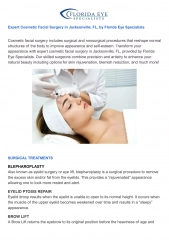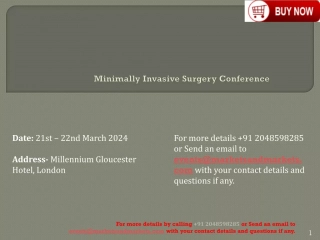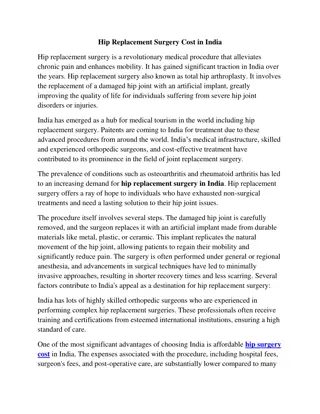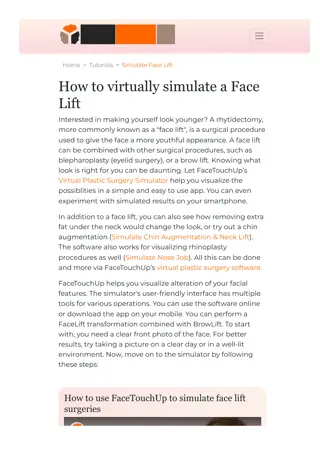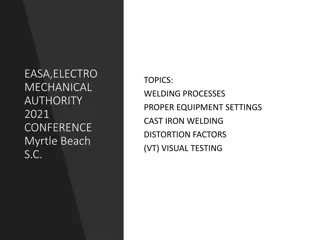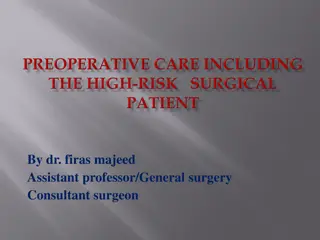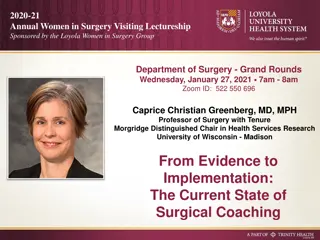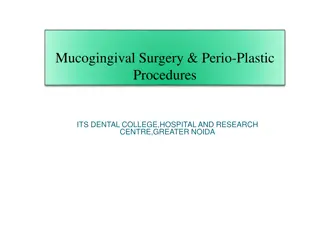Electro Surgery Unit
Learn about the principles of operation, function, and use of electro surgical units. Discover the history of this technology and its applications in surgical procedures.
- electro surgical unit
- surgical diathermy machine
- principles of operation
- function
- history
- scientific principles
- troubleshooting
- safety considerations
Download Presentation

Please find below an Image/Link to download the presentation.
The content on the website is provided AS IS for your information and personal use only. It may not be sold, licensed, or shared on other websites without obtaining consent from the author. Download presentation by click this link. If you encounter any issues during the download, it is possible that the publisher has removed the file from their server.
E N D
Presentation Transcript
Electro Surgery Unit Surgical Diathermy Machine Presented By : DAVIS WEKESA
Principles of operation function use scientific principles Troubleshooting identifying common faults replacing components rectifying faults construction components system diagram inputs/outputs Safety considerations user and patient safety electrical safety Performance monitoring calibration quality assurance and control preventive maintenance replacing components calibrating
? What is ELECTROSURGICAL UNIT Electro surgery is the application of a high-frequency electric current to biological tissue as a means to cut, coagulate, desiccate, or fulgurate tissue. Electrosurgical devices are frequently used during surgical operations helping to prevent blood loss in hospital operating rooms or in out patient procedure Electro surgery allows the surgeons to work faster as they do not have to tie off (close) every vessel they cut. The patient recovers better as there is less blood loss and there is more rapid healing.
History of electrosurgical unit For thousands of years human beings have used heat in the form of cautery to treat trauma and disease. By the late nineteenth century, as technology advanced, heat could be produced by electric current. the first electrosurgical unit was developed in 1926 by Dr. William T and Dr. Bovie The term "diathermy" is derived from the Greek words "dia" meaning "through" and "thermos" meaning "heat."
SCIENTIFIC PRINCIPALS Electro surgery is accomplished by converting high frequency electrical current into heat, caused by the tissue resistance to the passage of electrical current (the tip of the active electrode is not hot). As current must pass through the body, at least two electrical connections must be made between the patient and the machine. The power needed is up to 400 w If the waveform is modulated it will coagulate blood and stop bleeding (coag setting). If the waveform is unmodulated the tissue is cut
PARTS Electrosurgical Generator main control unit of the diathermy system.it houses the electrical circuitry and controls the generation and delivery of the high-frequency electrical current. Types 1 > Monopolar Electrosurgical Generator. 2 > Bipolar Electrosurgical Generator 3 > multipurpose electrosurgical generator Active Electrode/ hand piece /surgical pen Return Electrode Connecting Cables Footswitch
Principal of electro surgery When electric current flows through biological tissue the following effects can be observed. 1.Thermic effect (heat ) 2.Feradic Effect 3.Electrolytic Effect
1.Thermal Effect Tissue is heated by electric current . The heating is dependent on the resistance of the tissue ,The current density and duration of application HEAT = I2Rtissue
2.Faradic Effect Electrically sensitive cell, such as nerve and muscle cells are stimulated by electric current. It is Undesirable effect when performing a radio frequency surgery Avoided by using alternating current of high frequency of at list 30kHZ (high frequency surgery )
2.Electrolyticeffect Electric current causes ion shift to occur in biological tissues. The positively charged ions would be shifted to the negative pole ,cathode and negative to positive pole ,the anode causing electrolytic damage to the tissue Avoided by using A.C current of sufficiently high frequency
Selectable Modes on a Surgical Diathermy Machine/Unit: 1. Cutting 2. Coagulation 3. Fulguration 4. Desiccation 5. TUR > Trans Urologic Resection
Fulguration: This is carbonization/burning up / sparking on tissue intentionally to destroy it. It is done at high voltage about 2 Kv and the Active Electrode does not have contact with the tissue. Desiccation: This is intentional slow dehydration of unwanted intracellular fluids to dry out causing tissue shrinkage. This is achieved by insertion of the Active Electrode Probe into tissue and apply prolonged power till the intended tissue Evaporation is complete.
Cutting/Bisecting/Resecting > This is tissue cutting due to rapid and continuous raptures of the cell membranes Coagulation: This is denaturation of Tissue Proteins resulting to Thickening of Blood Density due to cutting electrode heat dissipation/transfer.
TUR > Trans Urologic Resection : This is tissue cutting under water > cutting a fluid filled tissue, cutting a too wet tissue.
The success of desired surgical action depends on 1. Property of tissue 2. Shape of active electrode 3. Catting speed 4. Current intensity 5. Conductivity of active electrode 6. Depth of modulation
TYPES OF ELECTROSURGICAL TECHNIQUES 1. Monopolar 2.Bipolar Electrosurgical Unit Active Electrode Dispersive Electrode Dispersive Electrode Cable
For bipolar electrosurgery, the active and return electrodes are both held by the surgeon in one combined pen. Electrosurgical current in the patient is restricted to a small volume of tissue in the immediate region of application of the forceps. Bipolar Coagulation
Block Diagram/construction The generating unit, It is generally a solid state device that can produce 300 to 3000 kilo Hertz. It breaks up the 50 Hz from the wall into high frequency required using a transformer. Activation of the electro surgery is done by the surgeon Using either a hand switch on the pen or by stepping on a foot switch High frequency generation 115v 60HZ
Electrosurgical machine: Construction r 'I Audio tone generator - - Power supply Logic/ Control Board Rely board -- ~ \.. r Main CPU - - . - Front panel ~ \. - - r . - ~ ~ ~ LED display 4 ,, \. , Power O/P or RF board - r "I Foot switch i r \.. h Patient return electrode ~ RF output I
The Bovie pen (ESU Pen) is held on the patient by the surgeon. The dispersive electrode can be a metal plate covered with a conductive gel or saline soaked cloths. Many are single use dispersive electrodes. Needle tip Blade tip Ball tip Poor contact with the dispersive electrode is the most common cause of patient burns .the ESU does not go on or gives an alarm if the dispersive electrode has no touch with the patient
SURGICAL NEUTRAL ELECTRODE PLATES Different Names: Patient Plate Neutral Plate Return Plate Dispersive Plate Passive Plate Types of Neutral/Patient Materials: Lead plate 3mm thickness (re-usable type). Flexible metallic plates up to 2.5mm e.g Phosphor ,Bronze: (re-usable type). Stainless steel plate 0.8mm reusable. Carbon impregnated silicone rubber (re-usable type). Aluminum Plate 1.5mm (Reusable few/limited times ). Aluminum foil neutral electrode 0.012mm thickness (one use /throw away type).
Troubleshooting The most common problems in electro surgery are: burns, excessive tissue damage, damage to alternate sites (areas of the patient's body other than the target surgical site) fires interference with other devices. Skin burns are the most frequently reported of these problems, Usually occurring at the return electrode site. Partial or complete detachment of the electrode pad from the patient is the most common cause. The dispersive electrode should always be placed on an area of the body that has good blood flow and is not subject to high weight concentration. The side of the thigh is a very common location, under the buttocks is not a good location as it generally is a high weight bearing point.
If the tip is dirty, there can be little, or no, current passing through the patient. The bovie pens are not intended to be reused. However, they are often reused In addition to problems with dirty tips, the wires become broken with reuse. They are simple wires which can be re-soldered for repairs. If the wire break is in the pen, the pen can be taken apart, the wires reconnected and the pen glued together The most important action in preventive maintenance is to keeping the inside and outside the machine clean. Check the plate electrode
Electrosurgical machine: Safety considerations The ESU is inherently a potentially dangerous device. All members of the surgical team using an ESU must be fully aware of the hazards, understand the principles of operation and safe handling, and be familiar with the abilities and limitations of their particular unit (training !) The main risks associated with electrical surgery Burns Electrical interference with the heart muscle Explosion/fire caused by sparks and Electrical interference with pacemaker and other medical equipment. Sparks are a common occurrence when electrosurgery is in use. When oxygen is being administered to the patient, it may leak, creating an atmosphere where tires can quickly ignite.
Electrosurgical machine: Performance monitoring An electrosurgery unit can be checked and calibrated electrosurgery tester. You cannot test the device by performing the Ohms would work, only a resistor with a very large power resistors are generally not available in the developing world. In most cases, a bar of soap or a fresh piece of citrus fruit (like an orange) can be used to do your initial testing. Be sure that both sides of the dispersive electrode are touching to prevent an alarm. easily and efficiently through the use of an operation on a resistor in most cases. Although 400 large power rating will survive the procedure. Such In many cases, you will want a final test on meat. A reasonable final test is to cut a raw piece of chicken, pork or beef. Both sides of The dispersive electrode must touch the meat to avoid an alarm! It is best to conduct the final test with the physician present. In this way, you can not only assure that the device is operating, but you can also be sure that it is operating in a manner that satisfies the physician. For more modern units, insure that the dispersive electrode alarm is working by disconnecting half of the electrode from the meat, or pulling the dispersive electrode out of the machine.


